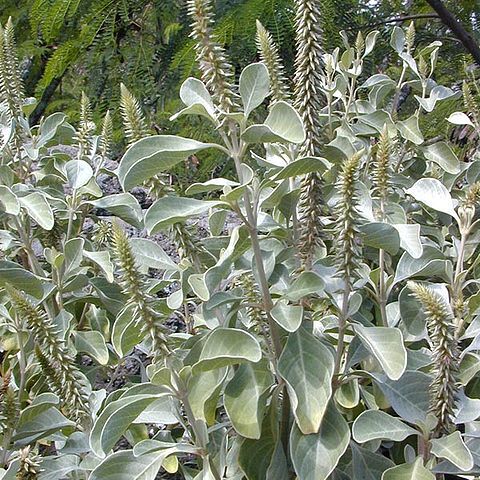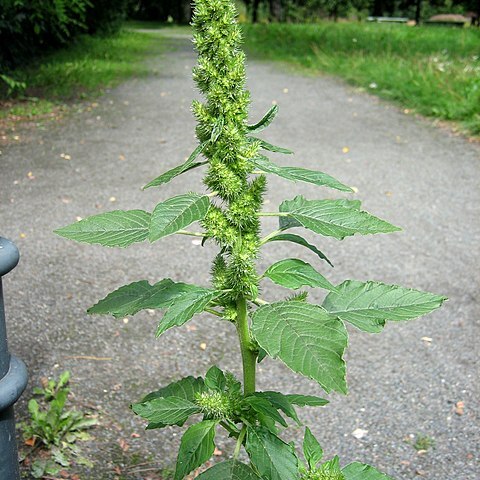Herbs, rarely subshrubs, annual or perennial; trichomes simple (branched in Tidestromia). Stems without nodal spines (Amaranthus spinosus sometimes with paired nodal spines). Leaves alternate or opposite, exstipulate, usually petiolate; blade margins entire (entire or serrulate in Iresine; entire, crispate, or erose in Amaranthus). Inflorescences cymules arranged in spikes, panicles, thyrses, heads, glomerules, clusters, or racemes; each flower subtended by 1 bract and 2 bracteoles (latter sometimes 1 or absent in Amaranthus). Flowers bisexual or unisexual (plants then monoecious or dioecious), hypogynous, generally small or minute; tepals mostly (1-)4-5 or absent, distinct or connate into cups or tubes, scarious, chartaceous, membranaceous, or indurate; stamens 2-5, filaments basally connate into cups or tubes, rarely distinct, alternating with pseudostaminodes (appendages on staminal tubes) or not, anthers 2-locular with 1 line of dehiscence or 4-locular with 2 lines of dehiscence; ovary superior, 1-locular; ovules 1 or, rarely, 2-many; style 1 or absent; stigmas 1-3(-5). Fruits utricles, dry, dehiscent or not. Seeds black, reddish brown, or brown, lenticular, subglobose or globose (rarely cylindric), usually small; embryo peripheral, surrounding mealy perisperm.
Herbs, ephemeral, annual, biennial or perennial, or shrubs, rarely climbing shrubs; monoecious or dioecious. Leaves opposite or alternate and spiral, simple, entire, rarely crenulate, sinuate or denticulate; petiolate to sessile; exstipulate. Inflorescence terminal or axillary, in glomerules, spikes, racemes or panicles, single to several in leaf axils. Flowers bisexual or unisexual, regular; each flower subtended by 1 bract and 2 bracteoles. Perianth of 3–5 tepals, equal to subequal, imbricate, free or united, enclosing fruit and falling with it, or persistent. Stamens 2–5, opposite the tepals, free or fused; staminodes present or absent; psuedostaminodes present or absent; anthers 1 or 2 locular, dehiscing by extrorse longitudinal slits, dorsifixed, versatile. Ovary superior, rarely stalked, unilocular with 1 to many ovules; style single or 2–3, entire or branched, terminal, rarely eccentric; stigma capitate, bilobed to filiform; placentation basal, funicles present. Fruit either an indehiscent utricle or circumscissile capsule, rarely a succulent berry. Seeds 1 to many; embryo curved; aril rarely present (not in Australia).
Herbs, clambering subshrubs, shrubs, or lianas. Leaves alternate or opposite, entire, exstipulate. Flowers small, bisexual or unisexual, or sterile and reduced, subtended by 1 membranous bract and 2 bracteoles, solitary or aggregated in cymes. Inflorescences elongated or condensed spikes (heads), racemes, or thyrsoid structures of varying complexity. Bracteoles membranous or scarious. Tepals 3-5, membranous, scarious or subleathery, 1-, 3-, 5-, or 7(-23)-veined. Stamens as many as tepals and opposite these, rarely fewer than tepals; filaments free, united into a cup at base or ± entirely into a tube, filament lobes present or absent, pseudostaminodes present or absent; anthers (1-or)2-loculed, dorsifixed, introrsely dehiscent. Ovary superior, 1-loculed; ovules 1 to many; style persistent, short and indistinct or long and slender; stigma capitate, penicillate, 2-lobed or forming 2 filiform branches. Fruit a dry utricle or a fleshy capsule, indehiscent, irregularly bursting, or circumscissile. Seeds lenticular, reniform, subglobose, or shortly cylindric, smooth or verruculose.
Stamens isomerous with and opposite the tepals, rarely fewer; filaments free or frequently more or less fused below, sometimes almost completely fused and 5-toothed at the apex with entire or deeply lobed teeth, occasionally some anantherous, alternating with variously shaped pseudostaminodes or not; anthers unilocular or bilocular
Flowers hermaphrodite or unisexual (plants dioecious or monoecious), mostly actinomorphic, usually bibracteolate, frequently in ultimate 3-flowered cymules; lateral flowers of such cymules sometimes sterile, modified into scales, spines, hooks or hairs
Fruit an irregularly rupturing or circumcissile capsule, rarely a berry or crustaceous, usually with rather thin, membranous walls; seeds round to lenticular or ovoid, embryo curved or circular, surrounding the more or less copious endosperm
Perianth uniseriate, membranous to firm and finally indurate, usually falling with the ripe fruit included, tepals free or more or less fused below, frequently more or less pilose or lanate, green to white or variously coloured
Inflorescence a dense head, loose or dense and spike-like thyrse, spike, raceme or panicle, basically cymose, bracteate; bracts hyaline to membranous, stramineous to white, subtending one or more flowers
Ovary superior, unilocular; ovules commonly solitary, sometimes more numerous, erect to pendulous, placentation basal; style obsolete to long and slender; stigmas capitate to long and filiform
Stamens mostly 5, opposite the sepals, hypogynous; filaments united at the base into a short tube, often with staminodes between; anthers 1–or 2-celled, opening by longitudinal slits
Flowers actinomorphic, usually hermaphrodite, small, in spikes, heads or racemes, with often scarious bracts and bracteoles, the latter sometimes hooked
Ovary superior, 1-celled; style short or long; stigma capitate or 2–3-fid; ovules solitary or rarely several, on basal funicles
Annual or perennial herbs, rarely undershrubs or climbers; leaves alternate or opposite, simple, exstipulate
Seeds globose, compressed or ellipsoid, smooth; embryo annular, surrounding the copious endosperm
Sepals 3–5, free or nearly so, imbricate, more or less dry and membranous
Leaves simple, alternate or opposite, exstipulate, entire or nearly so
Annual or perennial herbs or shrubs, rarely trees or lianes
Fruit dehiscing by a lid or indehiscent
Petals absent


